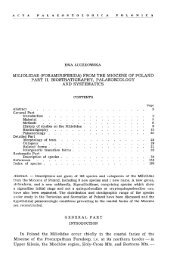Full text - Acta Palaeontologica Polonica
Full text - Acta Palaeontologica Polonica
Full text - Acta Palaeontologica Polonica
Create successful ePaper yourself
Turn your PDF publications into a flip-book with our unique Google optimized e-Paper software.
CAZE ET AL.—COLOUR PATTERNS IN AMPULLINIDAE 345<br />
shell morphology. As a corollary we regard them as general<br />
within the Ampullinidae and, whether plesiomorphic or result−<br />
ing from convergence, they do not appear to be systematically<br />
informative. Consequently, in this case, the residual patterns<br />
of the Class I do not reliably discriminate ampullinid gastro−<br />
pods from naticids, although this pattern morphology is rarely<br />
encountered in fossil Naticidae (Le Meur 2009). Some spe−<br />
cies, e.g., Globularia (G.) patula (Lamarck, 1804) and Amau−<br />
rellina sinuosa (d’Orbigny, 1850), display sharply delineated<br />
spiral stripes, which never diffuse with growth. Thus, these<br />
peculiar stripes do not appear as a result from variation of the<br />
background. They might be real elements of pattern, as in the<br />
Recent helicid land snail Cepaea nemoralis (Linnaeus, 1758).<br />
In this case, there would be a transition from background vari−<br />
ation to real elements of patterns in the genera Globularia and<br />
Amaurellina.<br />
Class II: All the species of Globularia, excepting Globu−<br />
laria (G.) patula, reveal patterns of Class II, alone or super−<br />
imposed on a pattern of Class I (Figs. 4, 5). The absence of<br />
this pattern in the other genera of the family makes us con−<br />
sider it as probably more derived. Thus the striking similarity<br />
of the pattern between the various fossil species of Globu−<br />
laria (Figs. 4, 5) and with the sole extant species, G. (Cerni−<br />
na) fluctuata, suggests a close relationship. This type of thin<br />
axial fluorescent zigzagging stripes is absent in naticids (Fig.<br />
11; Table 1) allowing an easy distinction of all the species of<br />
Globularia from those of the Naticidae and supporting their<br />
inclusion to Ampullinidae.<br />
Class III: Our observations demonstrated that the species<br />
of Pachycrommium reveal similar patterns of Class III (Fig.<br />
8, 9). This class of pattern is absent in all other Ampullinidae<br />
with the exception of rare specimens of Amaurellina leves−<br />
quei. Thus this character, almost unique to Pachycrommium,<br />
can be regarded as a second probable derived pattern within<br />
the Ampullinidae suggesting a certain unity within this ge−<br />
nus. Furthermore, this class of pattern is never observed in<br />
Naticidae and allows this genus of Ampullinidae to be distin−<br />
guished from the Naticidae. Besides, the similarity between<br />
the pattern morphology of P. acuminatum and G. (Cernina)<br />
sp. indicates that both genera, Pachycrommium and Globu−<br />
laria, seem phylogenetically not very distant.<br />
Class IV: Three species of Ampullina (Ampullina. inter−<br />
media, A. merciniensis, and A. lignitara; Fig. 3) display fluo−<br />
rescent poorly organised elements and sometimes thin sinu−<br />
ous axial segments. Among the studied taxa, this pattern is<br />
more similar to the peculiar pattern of the Class II of Globu−<br />
laria than any other known from the other genera. This sug−<br />
gests that Ampullina and Globularia seem phylogenetically<br />
not very distant too.<br />
Fig. 11. Comparisons of residual colour patterns between Naticidae and Ampullinidae under UV light. A–C. Naticidae. Indeterminate class: parallel zigzag−<br />
ging stripes, few zigzags per stripes, homogeneous zigzags’ amplitude. A. Natica stoppanii Deshayes, 1864, MNHN A42002 (MNHN coll.), Cuise−<br />
Lamotte, Oise, France, Ypresian (Cuisian), in apical (A 1) and dorsal (A 2) views. B. Payraudeautia perforata (Deshayes, 1864), MNHN A31803 (MNHN<br />
coll.), Grignon, Yvelines, France, Lutetian, in dorsal view. C. Cepatia cepacea (Lamarck, 1804), MNHN B58269 (MNHN coll.), Croix−Blanche, France,<br />
Lutetian, in ventral view. D–F. Ampullinidae. Class II: non−parallel zigzagging stripes, numerous zigzags per stripes, heterogeneous zigzags’ amplitude.<br />
D. Globularia (Cernina) compressa (Basterot, 1825), MNHN A30400 (MNHN coll.), Mérignac, Gironde, France, Aquitanian, in dorsal view. E. Globu−<br />
laria (s.s.) sigaretina (Lamarck, 1804), MNHN A30859 (MNHN coll.), Grignon, Yvelines, France, Lutetian, in dorsal view. F. Globularia (s.s.) semipatula<br />
(Deshayes, 1864), MNHN A30488 (Faullummel coll.), Cuise−Lamotte, Oise, France, Ypresian (Cuisian), in ventral view. Scale bars 10 mm for all, except<br />
5 mm (B, C). Photographs by C. Lemzaouda and P. Loubry (MNHN).<br />
doi:10.4202/app.2009.0084
















